20 July-6 Aug 2013. I hardly know where to begin with sharing the Guelaguetza Festival. Honestly I’ve felt a bit overwhelmed by it all – how to organize it in a way that best conveys what it was for us, what it is for the thousands of people involved both as performers and audience. We went to stunning performances every day for ten days, every one of them exhilarating, exciting, joyful. Thousands of photos to sort through to try to choose the best of them to share, torn between what I think are good photographically (and so my ego wants to include them) and those that really share something of the feel of this most colourful and exuberant of festivals whether or not they are “perfect” photos. Finally with Don’s help I found a balance and still couldn’t get it down below 120 photos.
Firstly a little about Oaxaca: it’s one of the southern states of Mexico, the capital also being Oaxaca, officially Oaxaca de Juarez. As the “tail” of Mexico swings around to the east Oaxaca’s coast has much more of an east/west orientation than the usual north/south orientation that we think of with Mexico. It has the highest number of indigenous people of any state, perhaps as high as 50 percent compared to 20 percent for the rest of the country. Sixteen separate ethnic groups are officially recognized. The most predominant are the Zapotec and the Mixtec, both of whom were eventually conquered by the Aztecs. There are some older people who only speak their native language, some who speak both their indigenous language and Spanish, and the younger ones who speak Spanish, and are learning their indigenous language. These cultures survived mainly due to villages being isolated because of the mountainous terrain of the state, and many people in the villages still live in the traditional way.
The city of Oaxaca de Juarez, naturally more cosmopolitan than the villages, has a Spanish colonial feel with some beautiful streets and churches, especially in the old central district.
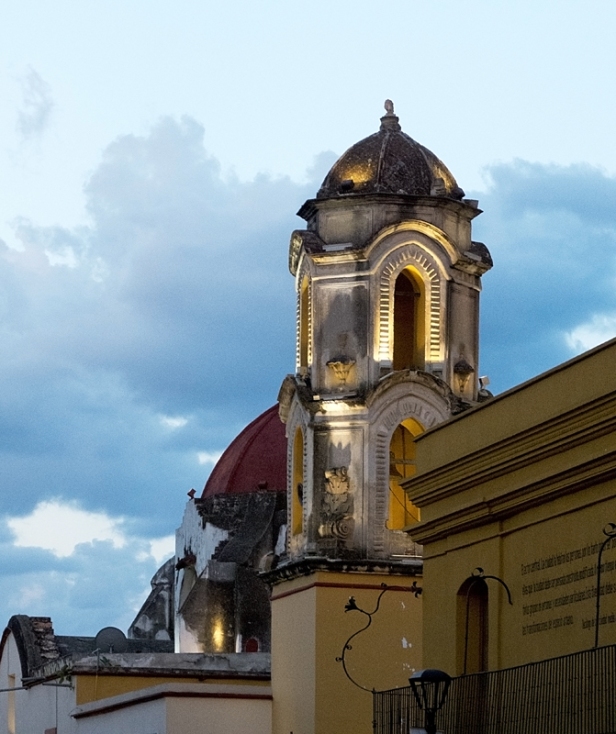


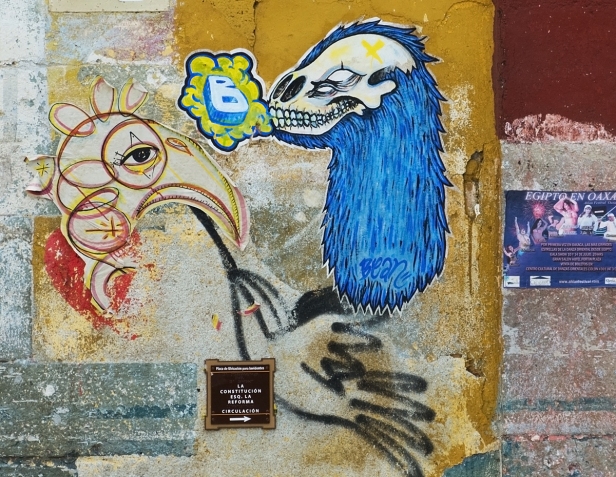
The Aztec lineage is alive and well
Women from one of the villages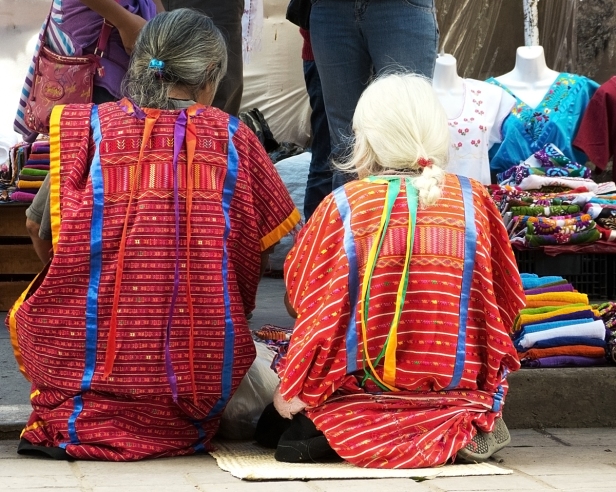
The whole town was overrun with tourists, the very large majority of them being Mexican (from all over the country), in town for the festival. I caught these three having a sidewalk break
Anyone who thinks that Mexicans are lazy, or more politely, laid back, disorganized, all about “mañana”, should think again. The Guelaguetza Festival is a huge annual two-week affair in both the city and several of the villages, embracing several daily dance performances (some in free outdoor venues, some in theatres), a food festival, a mescal festival, a mushroom festival, puppet performances, two large parades, performances by the State Traditional Folk Ballet company, four four-hour long performances at a sold-out stadium seating ten thousand, a competition for the Corn “Princess”, a mole (sauce) festival, two dance/pageant performances of a key piece of Oaxacan history at the again sold-out stadium, and more. Overwhelming much? It all ran like clockwork. I was constantly impressed with the organization, commitment and enthusiasm of everyone involved in making it all happen. I was especially impressed with the immediate and professional and caring medical help I received when I fell and hurt my head quite badly at the stadium.
There was so much to do and see, but rather than cram our days full we decided to focus on the dancing, and have time as well to explore the zocalo (traditional town square), and the markets and back streets of Oaxaca, and time to rest when we needed. We wanted to go the Guelaguetza celebrations in at least one of the villages to get a more intimate feel for it, and we decided we weren’t that much interested in picking mushrooms though we did eat some (more on that in a later post about our hike in the mountains). I’ll write more about the festival itself in the next post, but for now a taste of some of the delicious dance performances.
First, a couple of random shots of people in the audience that caught my eye

These children are from the Mixtepec culture. And oh how they danced, like true professionals and with such committment and character.


I couldn’t find out which culture or village these dancers represented
A little mescal fortification before the performance 🙂
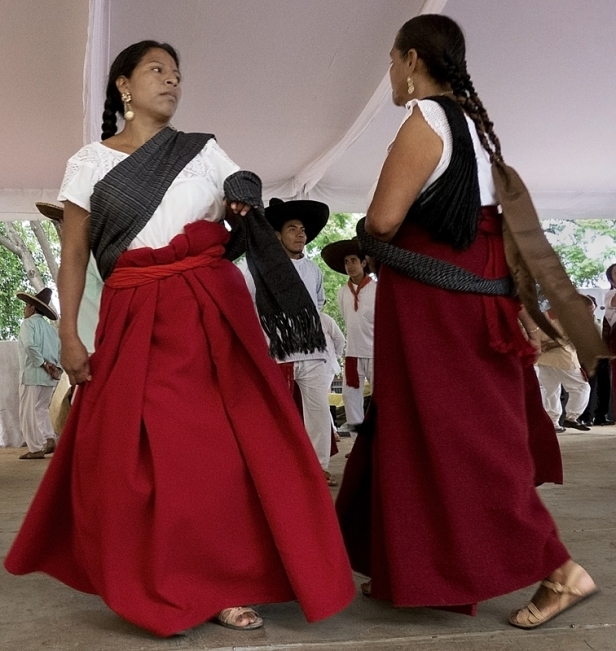
Dance of the Zancudos, by the Zapotecs from the village of Zaachila. Only men perform, half of them playing the role of women. They were breathtaking! So exciting. They danced as wildly as if they were on their feet on the ground. We were riveted. The first two photos were taken as they prepared to perform.


Towards the end a man came on to the side of the stage with his son (or perhaps protege) about four years old, and he danced along with the men. He already was beginning to get the feel for it. Many of the adult groups of dancers we saw had at least one young child participating.
These dancers are from Santa Maria Huatulco, in the coastal region. Their costumes may not be as spectacular as some of the others, but their wildly enthusiastic dancing and pure joy certainly made up for that.

Dance of the Rubios from the Mixtecs of Tecomaxtlahuaca. As soon as we saw the guy holding the animal over his head we knew that part of the performance would be a hunting dance, but this photo from Don really captures the mood of it all.

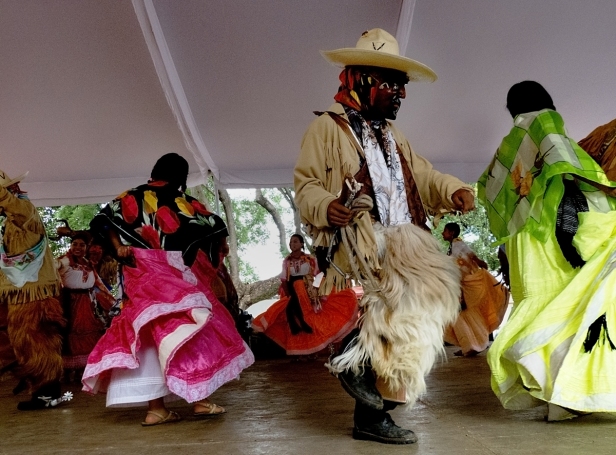
This is the Danza de Mascaritas from the Mixtecs of Teposcolula. There were three guys as skeletons, and three with deer heads. All six had rope whips and cracked them often. They paraded around the dancers. Once again all the dancers were men, and all wore mesh masks. It was surprising, and a bit puzzling how incredibly like English country dancing the dance patterns were – with a major costume twist! And wild crazy dancing that almost left us breathless with excitement. But then many of the performances were like that.



To add to the theme of English country dancing they produced a maypole! It was held in place by the three skeletons and the three deer guys while the dancers wove a perfect braid around the pole.
The dancers are from Santo Tomás Ocotepec

Don has really captured their movement in this photo
And this is just the beginning. In the next three posts I’ll share more information about the festival, and endless photos of dancers in the most beautiful, original, inventive, extraordinary, colourful, gorgeous costumes ever!
All words and images by Alison Louise Armstrong unless otherwise noted.
© Alison Louise Armstrong and Adventures in Wonderland – a pilgrimage of the heart, 2010-2015.

I can’t wait for the next instalment. What a brilliant festival.
LikeLike
Yes yes! A brilliant festival. It was so much fun, so enlivening. The joy was contagious.
Already working n the next post 🙂
LikeLike
Don did catch the dancers mid dance step…fantastic! You both have a great eye for an appealing photo. The culture is colourful and rich there in Mexico! Can’t wait for more 🙂
LikeLike
Didn’t Don do a great job catching the dance! Yes, it’s a very rich culture. We loved it, everywhere we went. More coming soon 🙂
LikeLike
Viva Mexico! Mesmerizing photos! Can’t wait to see more!
LikeLike
Thanks re the photos. And yes! Viva Mexico! We found ourselves shouting that along with the crowd at the performances, and at the parade. Viva Mexico! Viva Oaxaca! Viva Guelaguetza! So much fun.
LikeLike
Great photos and storytelling, as always!
LikeLike
Thanks Naomi. Glad you enjoyed it.
LikeLike
Love Oaxaca and love this post! Bravo~
LikeLike
Thanks Cindy. We love Oaxaca too. So glad we went there.
LikeLike
Maypole dancing in Mexico? Who knew? These are really exuberant photos – loved them!
LikeLike
Thanks Fiona. Yeah, maypole dancing! Amazing.
See you in a few days. Yay!
LikeLike
What a great time that must have been. Love the photos, one can almost feel the music coming off the page. Great post! xoxo
LikeLike
Thanks Paulette. Yes it was a fabulous time. I’m so glad we stumbled into it. Serendipity again.
(PS I voted again for you :))
xoxox
LikeLike
Serendipity is so wonderful! And, big smooches to you for all your votes!
LikeLike
Ditto…..so wonderful to see the camaraderie, the colorful costumes, the exuberance through your eyes! Fun, fun, joy!
LikeLike
Oh yes! It was so much fun! Every day different dance groups. You never knew what wild costumes and exuberant dancing would be presented. Every day a feast!
LikeLike
I got excited just reading about the dancing and seeing your wonderful photos.
Can’t wait for more!
LikeLike
Oh good! I’m so glad the feeling is coming across. We had the most amazing time there. Lots more to come 🙂
LikeLike
i like your insert about thinking perhaps “Mexicans are lazy, or more politely, laid back, disorganized, all about “mañana”…ha-ha! quite the opposite and as one can see from these lovely photos the elaborate costumes, the extent and care hosting such a festival – Wow! i am amazed with the dancers on poles. i enjoyed reading this. thanks! 🙂
LikeLike
Thanks so much Sunshine. I’m glad you enjoyed it. After spending nearly 5 months in Mexico and going to several different places we’ve come away with a whole different perception of it. It’s a very rich culture and the people are rightly very proud of it.
LikeLike
i love the way they staunchly hold on to their traditions – language, customs…even when they move away from their homeland. something to admire about that. 🙂
LikeLike
Yes, and especially in Oaxaca. A lot of what Guelaguetza is about is the sharing of the traditions of all the separate indigenous groups.
LikeLike
🙂
LikeLike
The way you weave the tale with vivid photography is so engaging — I thoroughly enjoyed devouring this post over a cuppa tea; a wonderful way to kickstart the morning.
LikeLike
Thanks Laurie. Good to hear we enriched your morning cuppa 🙂
LikeLike
Great photos. The little boy looks really scared to be on those stilts. Seems like you guys had a great time and cant wait to see more of the photos. The wifey is itchy to get the traveling going.
LikeLike
Hi Thomas, thanks for visiting. Yes we had a fabulous time, it was an amazing festival. I don’t think the little boy was scared, he was just really really concentrating. He seemed pretty stable on the stilts, and actually danced to the beat of the music a little. I had a quick look at your site – good luck with the travelling. More photos coming soon.
Alison
LikeLike
I love your blog and your attitude toward traveling (and life). I have adopted an “off the beaten path” retirement as well. I’m now 63, single, and have been living and teaching in Vietnam since January, 2013. My objective has been to blend service with adventure and freedom. I’m always on the lookout for blogs that resonate with my view on life. I’ll be back frequently! Thank you.
LikeLike
Hi Mary, nice to meet you. Wow, Vietnam! We’ve been there twice and loved it, and have a friend who lived there for 3 years, but I can’t imagine us living there. I imagine it’s both wonderful and challenging 🙂
Thanks for visiting our blog. I hope you enjoy the stories of our journey.
Cheers
Alison
LikeLike
Extraordinary photos and beautiful area of the world
LikeLike
Thanks pirate! We loved Mexico, in a whole new way. When you live in North America Mexico has, shall we say, a certain reputation. Well we discovered a whole different Mexico – alive and vibrant and juicy and friendly and quite functional. Not at all like the US media would have you believe.
LikeLike
hello Alison and Don, I just discovered your blog from reading nomad Matt’s blog and the wonderful article about you both. I’m very inspired. What gorgeous photos! What kind of camera do you travel with?
LikeLike
Hi Vicki, thanks for visiting and thanks re the photos. I have a Panasonic FZ150, Leica lens, 24x optical zoom. It’s a bridge camera. I think I’m about ready to upgrade to a full DSLR if I can find s’thing that’s not too heavy. When you’re travelling all the time weight really becomes a consideration.
Cheers
Alison
LikeLike
I feel like dancing, Alison. So much joy in these photos. Like Sunshine, I appreciate the “laid back” comments. I’m not sure where that misconception comes from, but it needs to check itself with reality.
Can’t wait to see more. {{{Hugs]}} Kozo
LikeLike
Thank you Kozo. Lots more dancing pics to come so grab that wife of yours and your 2 boys and Rock On! 🙂
Yeah, the whole thing about Mexico. I guess you have to spend a little time there. It is true that they often have a more laid back way with getting things done, I think more so in the smaller towns. It is true that there are problems with drugs and drug gangs (just like in the US eh?, and other countries), *and* it is true that there is this whole fabulous thriving rich culture, and people who are rightly very proud of their country. I will eventually do a post about it.
(((((hugs)))))
Kozo
LikeLike
What an incredible festival. The wonderful photos give a feel of it but being there would be another thing entirely.
LikeLike
It was amazing, one of the best – every day more unique fabulous dancing and music. Next post about it coming up v soon 🙂
LikeLike